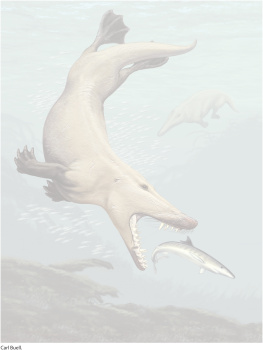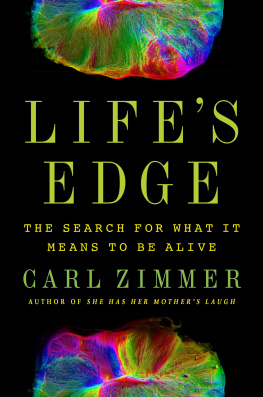Carl Zimmer - Evolution: The Triumph of an Idea
Here you can read online Carl Zimmer - Evolution: The Triumph of an Idea full text of the book (entire story) in english for free. Download pdf and epub, get meaning, cover and reviews about this ebook. year: 2006, publisher: Harper Perennial, genre: Romance novel. Description of the work, (preface) as well as reviews are available. Best literature library LitArk.com created for fans of good reading and offers a wide selection of genres:
Romance novel
Science fiction
Adventure
Detective
Science
History
Home and family
Prose
Art
Politics
Computer
Non-fiction
Religion
Business
Children
Humor
Choose a favorite category and find really read worthwhile books. Enjoy immersion in the world of imagination, feel the emotions of the characters or learn something new for yourself, make an fascinating discovery.

- Book:Evolution: The Triumph of an Idea
- Author:
- Publisher:Harper Perennial
- Genre:
- Year:2006
- Rating:5 / 5
- Favourites:Add to favourites
- Your mark:
- 100
- 1
- 2
- 3
- 4
- 5
Evolution: The Triumph of an Idea: summary, description and annotation
We offer to read an annotation, description, summary or preface (depends on what the author of the book "Evolution: The Triumph of an Idea" wrote himself). If you haven't found the necessary information about the book — write in the comments, we will try to find it.
Evolution: The Triumph of an Idea — read online for free the complete book (whole text) full work
Below is the text of the book, divided by pages. System saving the place of the last page read, allows you to conveniently read the book "Evolution: The Triumph of an Idea" online for free, without having to search again every time where you left off. Put a bookmark, and you can go to the page where you finished reading at any time.
Font size:
Interval:
Bookmark:
EVOLUTION
The Triumph of an Idea
Carl Zimmer

To Grace
In the history of life, five years is a blink. But for us humans, its a major chunk of chronology. When Evolution: The Triumph of an Idea was first published in 2001, life was very different than it is today. Our conversations today are full of words and names blogs, al-Qaeda that would have drawn blank stares five years ago. Five years have brought tremendous advances in science as well. We now know much more about the natural world, from stem cells to planets orbiting other stars. We also know much more about how life has evolved, thanks to tens of thousands of new scientific papers that have been published since 2001.
Some of the most exciting new research on evolution has built on the work I wrote about in this book, from the early evolution of life to the causes of mass extinctions, from the coevolution of males and females to the arms race between hosts and parasites. But to me, the most stunning body of work concerns the final part of my book: the evolution of humans. Its striking because it strikes closest to home.
In 2001 it had become clear that the closest living relatives to humans are chimpanzees and bonobos. This realization emerged from studies carried out in the 1990s on fragments of DNA from humans and other animals. Comparing these fragments allowed scientists to draw an evolutionary tree and determine which branches are closest to our own. Those studies also allowed scientists to estimate when our ancestors diverged from those of other apes. Over millions of years, mutations accumulate in a speciess DNA at a roughly regular pace. As a result, scientists can read a molecular clock by comparing the mutations that have accumulated in species that share a common ancestor. In the case of humans and chimpanzees, scientists estimated that their common ancestor lived five to seven million years ago.
But if the molecular clock was right, it meant that paleoanthropologists had a lot of work to do. In 2001 the oldest known hominid a species belonging to our own short twig of the evolutionary tree was a species called Ardipithecus ramidus. The fossil, discovered in Ethiopia, was 4.4 million years old. If the molecular clock was right, it might not actually be all that old. Hominids might have already emerged 2.5 million years earlier.
When Evolution: The Triumph of an Idea was originally published, those 2.5 million years were a vast void. But in just five years, the void has been populated by three different species of hominids. In 2004, the same team that found Ardipithecus ramidus reported the discovery of an older species in the same region of Ethiopia. Ardipithecus kadabba, as they named it, lived 5.7 million years ago. Meanwhile in Kenya, another team of paleontologists found six-million-year-old fossils, which they dubbed Orrorin tugenensis. And in the desolate emptiness of the Sahara desert, a third team unearthed a wonderfully preserved skull of a third species, which they estimate lived some time between six and seven million years ago. They named it Sahelanthropus tchadensis.
These discoveries represent a spectacular case study in how evolutionary biologists create hypotheses and test them. Given the evidence from DNA five years ago, one would have predicted that paleoanthropologists should find hominid fossils dating back between five and seven million years. Whats more, one would have predicted those fossils would be found in Africa. For one thing, all the hominid fossils older than two million years came from there, as do the closest living relatives of humans, chimpanzees, and bonobos. Both preictions turned out to be correct.
Scientific discoveries dont just confirm old hypotheses, however. They spur fresh debates of their own. Some scientists are arguing that these new hominid fossils are the first hints of an enormous diversity of early species. The hominid branch of the tree of life had a bushy base, these scientists maintain, and many of those shoots were cut short by extinction. Other researchers see things very differently. They argue that hominid evolution was much less extravagant, and they place Ardipithecus, Orrorin, and Sahelanthropus in a single genus. To them, the base of the hominid branch should look like a nearly straight line.
Another tantalizing question the new fossils pose is what the first hominids looked like. Early hominids probably stood about as tall as a chimpanzee and had a chimp-sized brain (about a third the size of ours). But they may have differed from chimpanzees and other living apes in one crucial respect: they may have walked upright. Orrorins femur is solidly buttressed, suggesting that it could have supported the weight of a hominids upper body. Sahelanthropus is known only from its skull, but it offers its own hints of bipedalism. The clues come from the hole where the spinal cord exits the base of the skull, known as the foramen magnum. In living apes, the position of the foramen magnum reflects how each species walks. Knuckle-walking chimpanzees walk with their backs tipped forward, and so their foramen magnum is located toward the back of their skull. Humans walk upright, with their back directly underneath their heads, and so the human foramen magnum sits at the base of the skull. Sahelanthropuss foramen magnum is positioned like a humans, suggesting it held itself upright. In other words, as far back in time as hominid fossils have been found, hominids seem to have been walking. The evolution of walking may thus have been the first major innovation that set hominids off from other apes.
While paleoanthropologists have been searching Africa for fossil clues about our evolution, other scientists have been searching our own DNA. Their search has accelerated dramatically thanks to the publication of the human genome in 2001. Instead of looking at a handful of short fragments of DNA, scientists can now analyze the entire three-billion-letter code. They can also compare the human genome to genomes of hundreds of other species, including rats, chickens, zebrafish, and chimpanzees. Since each of these species belongs to its own branch on the tree of life, scientists can find clues to our genetic history by comparing our genome to theirs.
This new research has made it clearer than ever that chimpanzees are the closest living relatives of humans. For long stretches, the two genomes are practically identical. In some cases, these stretches are genes that carry the codes for producing proteins. Even more remarkable are the broken genes that humans and chimpanzees share.
Some of the most striking examples of these broken genes come from our noses. All mammals carry several hundred genes for producing receptors on nerve endings in the nose. These genes evolved through accidental duplications. When a single gene became two, both genes at first encoded the same receptor. But then a mutation struck one of them, changing the receptors ability to catch odors. If the receptor did a worse job with the mutation, natural selection tended to delete the gene. But in some cases the mutation caused the receptor to catch a new odor molecule, expanding the smells the mammal could detect. Over millions of years, this process gave rise to a huge family of odor receptor genes.
In mice, dogs, and other mammals that depend heavily on their sense of smell, almost all the copies of these genes work properly. But in chimpanzees and humans, the majority of odor receptor genes are defective. They cant make a receptor at all. Scientists generally agree that these mutant genes must have accumulated in our genomes because ancient apes were evolving to rely less on their noses and more on their eyes. As a result, chimpanzees and humans share a strange legacy of our common ancestry: broken genes.
Font size:
Interval:
Bookmark:
Similar books «Evolution: The Triumph of an Idea»
Look at similar books to Evolution: The Triumph of an Idea. We have selected literature similar in name and meaning in the hope of providing readers with more options to find new, interesting, not yet read works.
Discussion, reviews of the book Evolution: The Triumph of an Idea and just readers' own opinions. Leave your comments, write what you think about the work, its meaning or the main characters. Specify what exactly you liked and what you didn't like, and why you think so.










